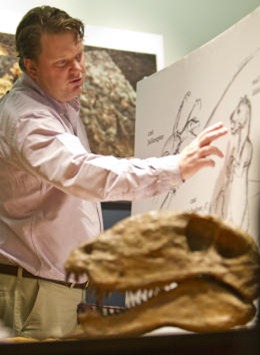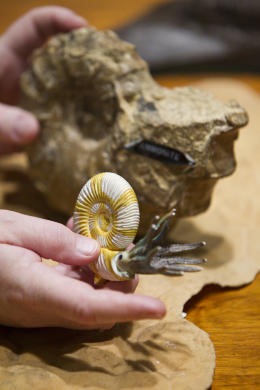With hip bones connected to thigh bones and leg bones connected to ankle bones, the Houston Museum of Natural Science's planned football field-size paleontology hall — part of an $85 million expansion set to open in summer 2012 — is an odds-on favorite to become the liveliest boneyard in town.
 Denizens of the hall will include favorites such as the menacing Tyrannosaurus rex, the 42-foot-long, 7½-ton Cretaceous period predator, and the birdlike reptile, Quetzalcoatlus northropi, whose skin-covered wings reached a span in excess of 30 feet.
Denizens of the hall will include favorites such as the menacing Tyrannosaurus rex, the 42-foot-long, 7½-ton Cretaceous period predator, and the birdlike reptile, Quetzalcoatlus northropi, whose skin-covered wings reached a span in excess of 30 feet.
All told, the hall will feature 26 dinosaurs among 61 major mounted skeletons, assistant paleontology director David Temple said. Those exhibits will be complemented by smaller skeletons, a veritable petrified forest, fossils and artistic renderings of prehistoric animals in action.
While the Houston museum's collection may not rival that of New York's American Museum of Natural History, said museum director Joel Bartsch, its presentation arguably will be the nation's most dynamic.
"This will not be old school," he said. "We're not renovating a historic space on the classic idea of displaying skeletons in a row. We're building a new structure. It will have 21st century interactivity."
Lots of action promised
One of the nation's most popular science museums with approximately half a million school kids passing through its galleries annually, the museum will meld academics with entertainment in an effort to convey how the hall's ancient occupants lived and died.
 "All the mounts will be in action," Bartsch said. "Everything will be chasing something; everything will be eating something."
"All the mounts will be in action," Bartsch said. "Everything will be chasing something; everything will be eating something."
Bartsch said the 200,000-square-foot addition, the seventh expansion of the 102-year-old museum since its current facility opened in the 1960s, will roughly double exhibition space and triple classroom space. The four-story building will include galleries to accommodate traveling exhibits.
Faced with severe space limitations in its current building, the science museum has held much of its collection out of sight in storage. With the new hall's opening, the public for the first time will see the bulk of the museum's 130-specimen Herb and Joan Zuhl petrified wood collection.
Prehistoric skeletons will be hauled from storage to join new acquisitions such as "Willie," a nearly complete Dimetrodon loomisiskeleton currently being excavated by the museum in Texas' Permian Basin. A fearsome Permian period carnivore, the sail-backed animal lived between 280-265 million years ago.
New, too, will be a remarkably well-preserved Triceratops, a three-horned plant-eating dinosaur that lived about 65 million years ago.
The specimen is a double rarity, Temple said. "You see a lot of skulls," he said, but only occasionally is a complete animal found.
Fossils, including a 100-plus-specimen trilobite collection, also will be displayed. Trilobites, ammonites and other invertebrate marine animals will be clustered around video viewing stations screening animated recreations of the ancient creatures scurrying across the ocean floor.
Paleo safari
Museum officials described the new paleontology hall as a "paleo safari," but Temple called it a "fight club."
The realistic juxtapositioning of the animals - many poised to eat or be eaten by their display mates - will be the new hall's defining characteristic.
Typical of the displays - augmented by dozens of artistic renderings of prehistoric life - will be the skeletal remains of a juvenile Tyrannosaurus rex attempting to raid a Quetzalcoaltus nest. In a diorama accompanying the display, the T rex has succeeded in munching an egg. But, confronted by several of the Late Cretaceous pterosaurs, its ultimate success is anything but assured.
"They creep me out," Temple admitted of the winged lizards, which could scurry across the ground to skewer prey with sharp beaks. The birdlike creatures were excavated from Texas' Big Bend, thought to have been the approximate point of impact of the Yucatan meteor that is believed to have extinguished dinosaur life.
The pterosaurs were named in honor of Quetzalcoatl, the Aztec plumed serpent god, and military aircraft designer John Northrup, who envisioned aircraft that, like the prehistoric animals, lacked tails. Paleontolgists are uncertain if the creatures were capable of flight.